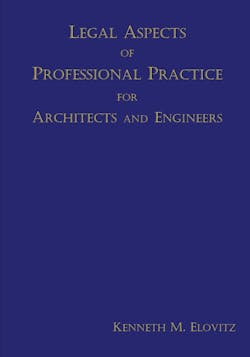Legal Aspects of Professional Practice: A Guidebook for the HPAC Community
By KENNETH M. ELOVITZ, PE, Esq., Energy Economics, Inc., Newton Centre, MA
Standard of Care... Performance-Based Codes... Construction Phase Services...
Do those terms evoke apprehension or spark curiosity? Perhaps they should, because they are part of an engineer’s duty when providing professional services.
Of course, every duty or responsibility should come with a corresponding bundle of rights. In turn, those rights are often duties that someone else owes the engineer. On a construction project, those people could be owners, architects, and contractors (including subcontractors and vendors).
Legal Aspects of Professional Practice for Architects and Engineers helps architects, engineers, and contractors understand their roles, rights, and responsibilities on a construction project. The book follows the trajectory of a typical project: design and contracts for services, then construction, including contract administration and dispute resolution. Later chapters discuss business organization, practice management, and how engineers contribute to developing codes and standards.
Standard of Care is shorthand for the overlapping and intersecting expectations of and from engineers. The Standard of Care plays a role in determining whether an aggrieved person has a viable claim against the engineer. For a claim to succeed, the plaintiff must show:
- The engineer had a duty to that plaintiff;
- The engineer breeched that duty, and;
- The breech resulted in the claimed damages.
Most of the parties’ rights and obligations are defined by their contract. While oral contracts for engineering services are generally enforceable, there can easily be disagreements over the scope and details of the agreement. For that reason, contracts for services should be in writing, signed by both parties. Some duties are defined by law, whether expressly contained in the contract or not.
For example, an architect or engineer impliedly promises to exercise “that skill and judgment which can be reasonably expected from similarly situated professionals” (Legal Aspects, p. 33, citing City of Mounds View v. Walijarvii).
Claims against engineers often involve claims of negligent performance of a contractual obligation (doing the job/fulfilling the contract, but doing it poorly). Rejecting products submitted as equals (Legal Aspects, Chapters 15, 16, and 17) and processing the contractor’s applications for payment (Legal Aspects, Chapters 19 and 20) can give rise to claims against engineers. But every claim is subject to defenses. The question can come down to which is stronger, the claim or the defense.
As a general rule, claims that an engineer’s performance fell below the Standard of Care requires expert testimony from a fellow professional. To sustain (or defend) a claim of breach of the Standard of Care, the experts must establish with some precision the applicable Standard of Care (Legal Aspects, p. 165 citing Pond Hollow Homeowners Association v. The Ryland Group, Inc.).
Engineering, like medicine, accounting, and teaching, is a respected profession, but the practice of engineering is carried out as a business. Engineers therefore need to understand the difference between partnerships and corporations and how insurance operates to manage and transfer risk. Legal Aspects discusses those topics in Chapters 24 and 25.
As professionals, engineers also have the opportunity to participate in developing the codes and standards that guide their practice (Legal Aspects, Chapter 26). Engineers also need to understand the applicable ethics and professional responsibility rules and regulations (Legal Aspects, Chapter 29).
Legal Aspects of Professional Practice for Architects and Engineers is written by a practicing engineer who is also a lawyer and an educator. The information and insights nevertheless have value for other participants in the construction process: It is just as important for owners and contractors to understand what to expect of an engineer as it is for engineers to understand what is expected of them.
Legal Aspects is also a useful reference for lawyers who advise clients in the construction industry or are engaged in resolving construction disputes. There are citations to more than 300 cases often referenced in construction litigation. Besides establishing precedent and defining the law, some of the cases are interesting stories.
While the lawyers’ role is to advocate for their clients, that advocacy should be guided by the expectations the parties set in their agreements along with the expectations that society has for professional practice. The book discusses many of those expectations, making it a useful resource for lawyers and litigants alike.
The book is now available on Amazon.com.
------------------------------------------------------------
A member of HPAC Engineering’s editorial advisory board, the author is both a mechanical and electrical engineer, as well as in-house counsel for Energy Economics, Inc., a consulting engineering firm based near Boston MA. He can be reached at [email protected], and 508-543-2447.


